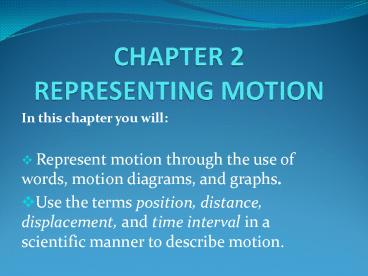CHAPTER 2 REPRESENTING MOTION - PowerPoint PPT Presentation
1 / 11
Title:
CHAPTER 2 REPRESENTING MOTION
Description:
Use the terms position, distance, displacement, and time interval in a ... Perceiving motion is instinctive your eyes pay more attention to moving ... – PowerPoint PPT presentation
Number of Views:658
Avg rating:3.0/5.0
Title: CHAPTER 2 REPRESENTING MOTION
1
CHAPTER 2 REPRESENTING MOTION
- In this chapter you will
- Represent motion through the use of words,
motion diagrams, and graphs. - Use the terms position, distance, displacement,
and time interval in a scientific manner to
describe motion.
2
CHAPTER 2 SECTIONS
- Section 2.1 Picturing Motion
- Section 2.2 Where and When?
- Section 2.3 Position-Time Graphs
- Section 2.4 How Fast?
3
SECTION 2.1 PICTURING MOTION
- Objectives
- Draw motion diagrams to describe motion.
- Develop a particle model to represent a moving
object.
4
INTRO/ALL KINDS OF MOTION
- Perceiving motion is instinctive your eyes pay
more attention to moving objects than to
stationary ones. Movement is all around you. - Movement travels in many directions, such as the
straight-line path of a bowling ball in a lanes
gutter, the curved path of a tether ball, the
spiral of a falling kite, and the swirls of water
circling a drain. - When an object is in motion, its position
changes. Its position can change along the path
of a straight line, a circle, an arc, or a
back-and-forth vibration. - When beginning a new area of study, it is
generally a good idea to begin with what appears
to be the least complicated situation, learn as
much as possible about it, and then gradually add
more complexity to that simple model.
5
ALL KINDS OF MOTION
- A description of motion relates to Place and
Time. - You must be able to answer the questions of where
and when an object is positioned to describe its
motion.
6
MOTION DIAGRAMS
- Motion Diagram a series of images showing the
positions of a moving object taken at regular or
equal time intervals.
7
THE PARTICLE MODEL
- Particle Model is a simplified version of a
motion diagram in which the object in motion is
replaced by a series of single points.
8
QUESTION 2
- A car is moving at a speed of 90 km/h. What is
the speed of the car in m/s? (Hint Use
Dimensional Analysis) - 90 km 1 h 1000 m 25
m/s - h 3600 s 1 km
9
QUESTION 1
- Explain how applying the particle model produces
a simplified version of a motion diagram? - Keeping track of the motion of the runner is
easier if we disregard the movements of the arms
and the legs, and instead concentrate on a single
point at the center of the body. In effect, we
can disregard the fact that the runner has some
size and imagine that the runner is a very small
object located precisely at that central point. A
particle model is a simplified version of a
motion diagram in which the object in motion is
replaced by a series of single points.
10
QUESTION 2
- Which statement describes best the motion diagram
of an object in motion? - A graph of the time data on a horizontal axis and
the position on a vertical axis. - A series of images showing the positions of a
moving object at equal time intervals. - Diagram in which the object in motion is replaced
by a series of single point. - A diagram that tells us the location of zero
point of the object in motion and the direction
in which the object is moving. - B A series of images showing the positions of a
moving object at equal time intervals is called a
motion diagram.
11
QUESTION 3
- What is the purpose of drawing a motion diagram
or a particle model? - To calculate the speed of the object in motion.
- To calculate the distance covered by the object
in a particular time. - To check whether an object is in motion.
- To calculate the instantaneous velocity of the
object in motion. - C To check whether an object is in motion.































